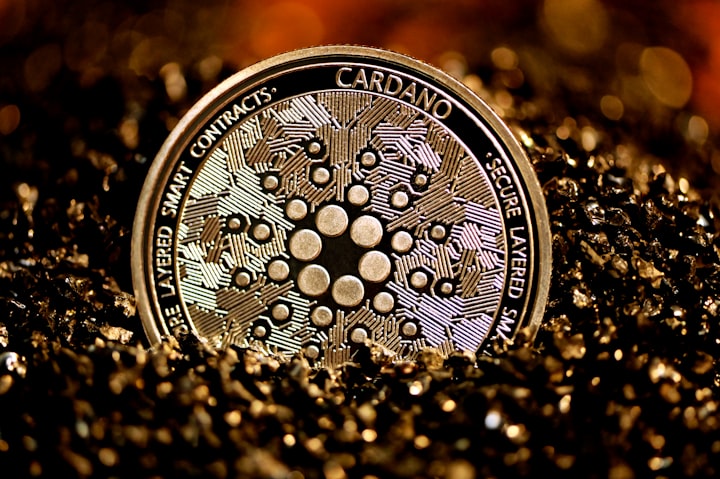Cardano v. Polkadot: Which Is Better Long Term?
There Is One Key Reason Cardano Is Winning
The cryptocurrency world extends far beyond Bitcoin. Right now, the stiffest competition concerns who can develop the best blockchain platform for hosting other blockchain apps on it. This competition among competitors is called the platform wars.
This is the fight to be the cryptocurrency world’s equivalent of the Apple and Android smartphone platforms. The one or two (or maybe three) winners will get to be the primary platforms on which all the other cryptocurrencies run.
In this competition, Polkadot (DOT) and Cardano (ADA) aren’t just competing with each other. They are competing with Ethereum (ETH), Bitcoin (BTC) which will have smart contracts in November, Internet Computer (ICP), and for decentralized finance Solana (SOL) and Terra (LUNA), among others.
I think that Cardano’s technology is about as good as Polkadot’s, even if they are quite different. Where Cardano wins--and this matters for me as an investor--is in community engagement. I’ll explain why I think that and why community engagement matters for this battle in three points.
Let’s start with the basics.
1 The Basics
So that we’re all on the same page, let’s review some basic points.
Both DOT and ADA are proof of stake platforms. This means that they don’t have specialized machines called miners to validate their blockchain. That not only makes them more eco-friendly than Bitcoin, but it’s also a lot faster. That speed is why Ethereum is planning to become a proof of stake blockchain too.
Both the founder of DOT (Gavin Wood, PhD) and the founder of ADA (Charles Hoskinson) originally worked on Ethereum. Wood is the man most responsible for developing Solidity, the programming language of Ethereum, but Hoskinson was also crucial.
They both left Ethereum because they were dissatisfied with the project, though in different ways. Hoskinson originally wanted to accept venture capital for ETH. Wood left Ethereum because he did not like how it lacked on-chain governance, i.e. the ability of coin holders to vote on changes to the blockchain.
Both coins are thus self-conceived Ethereum competitors, and they bring with them the advantage of hindsight. At the same time, they are literally years late to the game, and so do not have first-mover advantage.
The basic truth about Cardano (ADA) or Polkadot (DOT) is that they are less competing with each other than they are with Ethereum. Right now ETH 2.0, which is transitioning to Proof of Stake, might come out before either of these projects reach a critical threshold. They need both functional smart contracts, that’s what allows for a blockchain to host other applications as your desktop runs other programs, and the speed needed to run all those applications on the blockchain.
If Ethereum is first, then I imagine that there will be only one platform: Ethereum. In that scenario, Ethereum would be to blockchain what Amazon is to online retail. Yes, other sites like Overstock.com and Ebay exist, but they are hardly competitors.
If Ethereum isn’t first to that milestone, then it’ll probably still be relevant but there will likely be three main blockchain platforms. That’s the scenario where ADA and DOT stand a chance.
For that possibility, you might want to consider two key features for long-term success: decentralization and project road maps.
2 Decentralization & Road Maps
Decentralization matters for any blockchain tech because it ensures that a blockchain is secure and cannot be manipulated. There are some pretty easy metrics to assess whether a blockchain is decentralized and ADA has a fairly clear advantage on this score.
ADA has the most decentralized staking of any cryptocurrency. DOT, by contrast, has 1000 maximum validators, meaning that it’ll never be truly decentralized.
80% of all ADA coins are in the hands of the community. DOT is not bad in this regard, but it has only 50% of its coins in the hands of its community.
Decentralization is not an overwhelming advantage, because the blockchains need to grow large enough that decentralization matters.
So, the next logical place to check is the development road map each coin has. If there is a big gap here, then you’ll find a clear winner.
If you head on over to Cardano’s site, you’ll discover that it has moved onto the third phase of five planned developmental phases: Goguen. This is the phase focused on delivering a usable smart-contract network and is planned to be completed in August. This will make Cardano basically like Ethereum, but without all the D’Apps (distributed apps) Ethereum has. In its next phase, stage 4, Cardano will focus on scaling, but it should be noted that even at the completion of stage 3 (Goguen), ADA will be faster than Ethereum is presently. That’s the advantage of hindsight.
Polkadot, by contrast, is already focusing on scaling with their parachain rollout. You might think that this puts them ahead of Cardano, but their technology is quite different. They achieve scale and speed by having lots of parallel chains (called parachains) and then running a protocol to link them together.
For an image, think of a birdcage (Gavin would probably hate this image as the DOT team doesn't want to trap anything, but just hang with me). You have the bars going down, but they also need to be linked horizontally so they don’t move too much. In this case, the horizontal bars do the work of allowing the chains to communicate with each other. That’s called interoperability.
The problem for DOT is that the parachains they’re presently working on won’t be interoperable just yet. As a result, they’re not actually a step ahead of Cardano.
The tech review, then, suggests that the two projects are at a draw. There is one thing that can break this tie, and it’s adoption.
3 Community Adoption
Did you know that Windows had a smartphone? Yea. It did. It looked like this.

The reason you own an iPhone or an Android phone, and not a Windows phone, isn’t because the Windows phone platform sucked. The designers spent a lot of time developing an intuitive platform and it worked pretty well.
The problem is that Microsoft couldn’t get enough developers to write apps for their ecosystem. As a result, no one wanted to buy a smart phone with no apps … which meant that even fewer developers would be interested, etc. Without ever getting that critical mass of developers, the phone interface just didn’t matter.
Right now, Ethereum has about 90% of all distributed apps (D’apps). Other projects, like Terra (LUNA) have to put out tutorials about how to transfer your Ethereum to their network so that you can do stuff. The same holds for ADA and DOT.
As a result, if ADA or DOT is going to survive, then the community they develop will matter more than their tech. And in this regard, Cardano has done a significantly better job.
It may just be personality, but Charles Hoskinson has a near-daily vlog going and is working with specific early adoption communities in Africa seed his launch. He’s everywhere and even has his own video blog where he posts almost daily (you can see a random recent video here).
They aren’t snazzy, but they are real. No other founder is doing this and people are watching. Here’s one of his explanation videos that’s done more than 1.2 million views.
That engagement is what will matter for adoption and right now Cardano is doing a better job than DOT.
Concluding Thoughts
I’m an investor and trader of cryptocurrencies and I run a free newsletter called The Art of The Bubble with a community of people where we trade bubbles of all kinds, from cryptocurrencies to cannabis.
Most people interested in cryptocurrencies are similarly interested. What follows is not investment advice and I’m not a financial advisor. I just want to point out some numbers that might indicate price performance over the next 12 to 24 months (given that we are presently in something of a crypto-winter).
If you look at price declines since their all-time highs, Cardano has lost only 39% while DOT is down an unbelievable 68.75%. This means that just by returning to its previous all-time high, DOT would do more than 100% from its present value.
The idea I want to tease out here is that while Cardano is likely a better term investment, DOT might be a better trade. Let’s keep this analysis grounded in historical data so that we know we are talking about realistic possibilities.
Let’s look at Cardano first and assume that it does well going forward. Maybe it doesn’t surpass Ethereum, but in the next bull run, if it hit the market capitalization that Ethereum has today (after the crash), then it would do about 5x. If Cardano were to hit the market capitalization of Ethereum’s all-time high in May, Cardano would do about 10x from its current price.
Now consider DOT in the same conditions. If DOT were to hit Ethereum’s current value (market capitalization), it would do 17.87x its current price. If DOT were to hit Ethereum’s all-time high, it would do about 27x.
So, in the scenario that both Cardano and Polkadot did well, but neither surpassed Ethereum, they would both gain in value, but Polkadot would gain more. These numbers are suggested, moreover, by recent prices, so they aren’t the made-up figures that a lot of pumpers push.
On the downside, if Ethereum reaches its milestones before either of these do, then they probably won’t eclipse their May all-time highs in the next bull run. Probably that won’t happen, but who knows.
Right now, the market seems to be pricing the coins exactly in line with these considerations, as DOT has a much smaller market capitalization (value) than Cardano. Longer-term, then, I prefer Cardano because Hoskinson knows that adoption matters. With DOT, however, there is far more room to grow and it has possible larger gains.
If you found this helpful, feel free to join our free newsletter and share this article.
About the Creator
Sebastian Purcell
Philosopher. Analyist. Happiness Researcher | sebastianpurcell.com | Newsletter - Philosophy as a Way of Life - https://bit.ly/3oaBsno







Comments
There are no comments for this story
Be the first to respond and start the conversation.